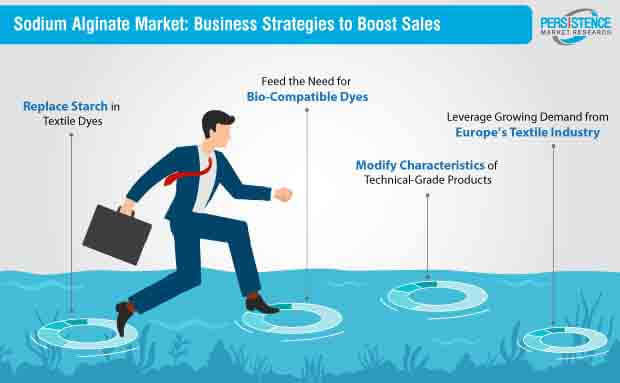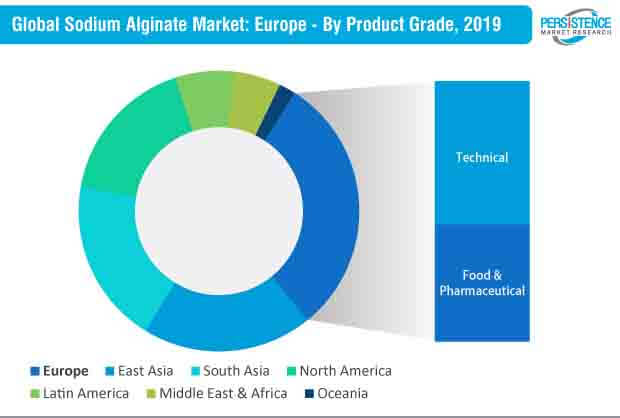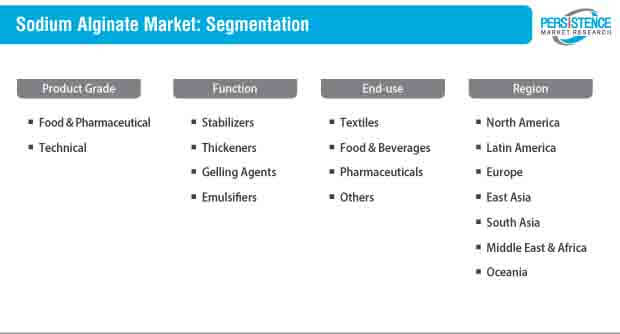Sodium Alginates Market Segmented By Food and Pharmaceutical, Technical Product Grade with Stabilizers, Thickeners, Gelling Agents, Emulsifiers Function
Industry: Chemicals and Materials
Published Date: June-2019
Format: PPT*, PDF, EXCEL
Delivery Timelines: Contact Sales
Number of Pages: 283
Report ID: PMRREP4375
Bio-based ingredients have been gaining popularity, not only in the food & beverage industry, but also in other industrial segments such as cosmetics, textiles, and printing.
Sodium alginate, which is extracted from seaweed, was discovered as an innovative ingredient that can be used in various applications, and this opened a new window of opportunities for the manufacturers of plant-based excipients. The broadening width of the range of applications of sodium alginate lead Persistence Market Research (PMR) to research on its growing commercial potential. The study tracks the developments in the sodium alginate market to unveil new growth opportunities for stakeholders in this landscape.

In 2018, the valuation of the sodium alginate landscape reached US$ 164 million, and, with manufacturers exploring applications in a wide range of industries, the market is expected to witness around 4% year-over-year growth in 2019. The demand for sodium alginate as a thickener and emulsifier in food and pharmaceutical industries accounts for approximately half of the revenue share of the global market. However, regulations associated with the safety of its consumption are limiting its demand in food products and pharmaceuticals.
With the growing awareness about the negative impacts of sodium on human health, sodium alginate is being replaced by safer alternatives in food and pharmaceutical applications.
The increasing availability of sodium alginate substitutes, such as natural gums, cornstarch, and maize starch, which do not have negative impacts on health, is restricting the scope for food-grade sodium alginate. Manufacturers are turning to new end-use industries such as cosmetics and textiles to expand the sales potential of sodium alginate and boost profitable sales in the coming years.

New companies have sprung up in the sodium alginate market with the rise of wide-ranging applications of technical-grade sodium alginate in recent years. Textile and printing & pigments dyeing industries are emerging as leading end-use industries in the technical-grade sodium alginate landscape. The annual production of sodium alginate has been increasing steadily, and the sales of technical-grade sodium alginate accounts for over 55% share of the global market.
The demand for sodium alginate in the textile industry has only grown with time, as it is an integral element used in various procedures such as warp sizing and dyeing pastes, in textile manufacturing. Increasing applications of technical-grade sodium alginate are mainly attributed to the growing preference for bio-based fibers, and also due to the chemical properties of sodium alginate that are superior to starch, making it an ideal coloring agent for the textile industry. Low-viscosity sodium alginate, when used in textile printing, facilitates in stabilizing the printing process and increasing the coloring yield.
Manufacturers in the sodium alginate landscape are likely to capitalize on the burgeoning growth of the textiles and clothing industry, as it is expected to grow from US$ 707 billion in 2012 to US$ around 1,060 billion in 2021.
Technical-grade, water-soluble sodium alginate is also expected to witness high demand in the paper industry, as it is being widely used to replace a part of rosin pulp in papermaking, so as to increase the crumpling resistance of paper, the smoothness of its surface, and to improve the absorption of printing ink.
Leading players in the sodium alginate industry are adopting new business strategies to sync with the increasing demand for low-cost and biocompatible polymers in most end-use industries. The incorporation of next-generation technologies, such as membrane technology in separation engineering, is surging, as manufacturers are planning to offer controlled characteristics of sodium alginate, such as viscosity and stability, to meet the specific requirements of different end users.
Market players are also aiming at capitalizing on the positive growth prospects of sodium alginate in the textile industry by attracting fashion-tech companies to invest in high-quality textile dyes.
The growing need for improving color consistency and reducing the environmental footprint in the fashion industry is aiding sodium alginate manufacturers in building their next business strategies. Since most fashion brands are moving away from synthetic dyes to biocompatible dyes, manufacturers are offering sodium alginate as a high-quality catalyst in the development of proprietary, sustainable coloring methods for textile and clothing companies.
In a highly fragmented market, such as the sodium alginate landscape, stakeholders are putting together their business strategies to uphold their positions in the market by maintaining the competitive costs. Through acquisition and collaboration strategies, large companies are focusing on gaining access to raw materials, mainly seaweed, to remain unaffected from fluctuating raw material prices.
In 2017, DowDuPont announced that DuPont has acquired the Health & Nutrition business of FMC Corporation – a leading company in the sodium alginate landscape. In May 2018, JRS Group – a leading manufacturer of excipients in the health science industry – announced that it received the regulatory approval from the European Commission for its acquisition of DuPont’s N&H alginate business.
Europe is likely to remain an attractive revenue pocket for a majority of sodium alginate manufacturers and distributors, as Europe’s textile industry accounts for nearly 40% share of the world’s textile industry. Despite the presence of stringent regulations and standards on seaweed harvesting in Europe, high demand in various end-use industries is expected to make Europe a profitable market for sodium alginate manufacturers in the coming years.
Market players are also foraying into the sodium alginate space in emerging economies to capitalize on the increasing growth of the textile printing landscape, especially in China and India. The low cost of raw materials and burgeoning growth of the food and pharmaceutical industries in China are boosting the potential for sodium alginate, and this is reflected in the mounting number of manufacturers and distributors in the sodium alginate landscape in East Asia.

The authors of this report believe that the sodium alginate market is expected to ride on the coattails of the textile industry in the coming years. The growing demand for bio-compatible fibers and dyes in textile manufacturing is expected to shape the future of the sodium alginate market.
However, the limited potential of sodium alginate in food and pharmaceutical applications will restrict the scope for development in this landscape. Manufacturers who focus on introducing innovative characteristics of sodium alginate to suit dynamic end-user requirements will gain a competitive edge in the market.
Significant Demand for Natural Products
European countries are implementing rules and regulations on the usage of synthetic chemicals for various end-use applications, especially in the food & beverage and pharmaceutical industries. Owing to this, the demand for bio-based products, i.e. sodium alginate, is increasing.
Furthermore, consumers are becoming more conscious as to the use of natural resources, and many make product choices that reflect their concerns regarding the environment. Attributing to the aforementioned factors, the sodium alginate market is growing at a steady pace.
High Growth in the Textile Industry
Steady economic growth in developing countries such as China, India, Brazil, and ASEAN countries, and rising per capita disposable income and expenditure in these regions, are the main factors that are driving the demand for consumer products such as clothing, food products, etc. The use of textiles in sportswear and medical applications is increasing, and the high demand for specific characteristics in fabrics is expected to open up new avenues for the textile industry.
In developed regions such as North America, textile manufacturers are more inclined towards manufacturing technical products such as technical textiles over commodity goods. Thus, textile manufacturers who are changing preference from manufacturing generic textile products to niche technical textile products are generating the demand for technical grade sodium alginate.
Strategic Developments Across Key Players
Industry participants of the sodium alginate market are emphasizing on key developments such as product launches, collaborations, expansion, and acquisitions. Key players are primarily targeting collaborations with small-scale manufactures and distributors to gain market attraction in the sodium alginate market. For instance,
PMR’s study on the sodium alginate market classifies information into four broader categories-product grade, function, end use, and region. The market dynamics and changing trends associated with the aforementioned segments of the sodium alginate market are featured in detail in this study. Segment-wise division of the information featured in PMR’s study on sodium alginate can help readers understand the specific information about the prospects of growth.
| Attribute | Details |
|---|---|
| Product Grade |
|
| Function |
|
| End Use |
|
| Region |
|
Detailed information about the sodium alginate market in the study is segmented based on seven geographical regions-North America, Latin America, Europe, East Asia, South Asia, the Middle East & Africa, and Oceania.
The study also offers valid reasoning and explanation on the how the revenue share was estimated for each segment of the global sodium alginate market, which can help market players make appropriate decisions in the coming years.
The study answers critical market-related questions for stakeholders, which can help decision-makers understand the dynamics of the sodium alginate market. Information featured in this PMR study can help market players track strategic innovations and developments in the sodium alginate market, and gain a competitive edge during the coming years.
To know more about delivery timeline for this report Contact Sales
